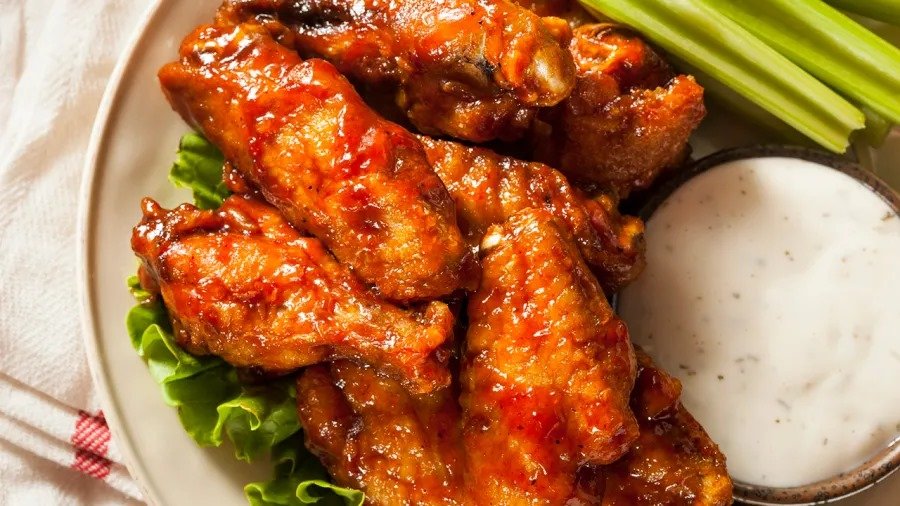WASHINGTON, D.C. – As we approach the second largest eating day of the year, following Thanksgiving, the demand for chicken wings is at its peak. According to the 2024 Wing Report by the National Chicken Council, Americans are expected to consume a staggering 1.45 billion wings while witnessing the Kansas City and San Francisco teams compete for the championship trophy.
Council spokesman Tom Super emphasized the perfect combination of football and wings, stating, “Football is fantastic, and wings are equally amazing. However, when enjoyed together, they create an unbeatable experience.” Super further added, “While chips, guacamole, and pizza may have their place, wings undoubtedly dominate the menus on the upcoming Sunday. So, grab a moist towelette and savor America’s favorite party food during the Big Game.”

To provide a Chicken Wings of the vast quantity of wings, consider the following:
The staggering amount of 1.45 billion wings would allow every individual in the United States, regardless of age or gender, to savor four wings each.
If Kansas City Coach Andy Reid were to consume 50 wings daily, it would take him an astonishing 79,452 years to devour the entirety of 1.45 billion wings.
The abundance of 1.45 billion wings would enable us to place 693 wings on every seat within all 30 NFL stadiums.
If we were to lay out the 1.45 billion wings end-to-end, they would extend for a distance equivalent to 1/3 of the way towards the moon.
To illustrate the passage of time, envision each wing representing a single second. In this scenario, 1.45 billion wings would signify a span of 46 years from now, specifically the year 2070.
The projection for this year remains unchanged compared to 2023, as per the USDA’s report on chicken production levels. It indicates a slight decrease from the previous year, with wing stocks in cold storage down by 13% in November compared to the previous year. This decline in supply could be a contributing factor to the increased demand and subsequently higher wholesale prices for wings. At the retail level, fresh chicken wing prices have decreased by approximately 5%, while frozen wing prices have dropped by 11% compared to January 2023, as stated by Circana data.

In the future, Buffalo’s participation in the Big Game could potentially boost wing consumption. Super mentioned that it might even lead to Taylor Swift once again showcasing her affinity for ranch dressing by dipping a wing this time around.
The historical background of buffalo chicken wings.
Southern cuisine has long embraced the tradition of deep-fried chicken wings. However, the story of how the idea of tossing wings in a spicy hot sauce came about is an interesting one. In 1964, at the Anchor Bar in Buffalo, New York, Teressa Bellissimo, one of the co-owners, decided to cook some leftover wings in hot sauce as a late-night snack for her son and his friends. The wings turned out to be a huge hit, and the Bellissimos wasted no time in adding them to the menu the very next day. Served alongside celery slices and bleu cheese sauce, these delectable treats became known as “Buffalo Wings” and quickly gained popularity.
Dick Winger, a hot sauce vendor, recognized the potential of this new culinary creation and joined forces with Dominic Bellissimo, the son of the owners, to promote the dish and sell their hot sauce. Gradually, the concept of buffalo wings started to catch on with restaurant operators across the country. The breakthrough moment came in 1990 when McDonald’s introduced “Mighty Wings” at select locations. This was followed by KFC’s launch of “Hot Wings” a year later, and Domino’s Pizza introducing their own version of wings in 1994. Since then, buffalo wings have remained a beloved and sought-after food item. McDonald’s even re-entered the wing market in 2013, featuring their “Mighty Wings” nationwide at most of their restaurants during the first quarter of 2014.
The rise of the chicken wing and its correlation to American football all had to do with timing.
During the 1960s and 1970s, it was fashionable to cook the entire bird. However, in the 1980s, boneless-skinless breast meat gained popularity among U.S. consumers, causing wings to become a cost-effective byproduct for chicken producers. Restaurants and bars quickly realized that they could offer wings at low prices due to their relatively inexpensive protein content. Additionally, they discovered that the spicy and salty nature of the sauce made customers consume more beer, leading to increased sales.
Simultaneously, the rise of sports bars equipped with multiple TVs and satellite dishes was facilitated by the rapid advancement of technology in America. Among the various sporting events, football became the most popular choice for friends to watch together in bars. Wings proved to be an ideal choice for sharing and affordability, making them a perfect accompaniment to a pitcher of beer. Thus, the bond between pigskin and chicken wings was established.
Wing Tips
Americans have a greater inclination towards consuming bone-in, traditional wings (53%) compared to “boneless wings.” The breast is favoured by two out of five (38%) Americans as their preferred cut of chicken, while wings (20%) come in second. When it comes to wing sauces, BBQ (52%), ranch (46%), and buffalo/hot sauce (41%) are the top choices. As for the preferred side dish for wings, French fries take the lead by a significant margin (72%), followed distantly by celery (14%).
